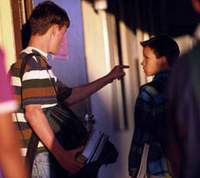School bullying develops into army hazing and sexual abuse in prisons
I remember an incident that I witnessed a few years ago. I worked as a school psychologist back then. One day I was walking along the school hallway during a recess. Suddenly I caught a glimpse of a nasty scene in progress. I saw four eighth-grade students kicking at their baldheaded classmate. The kid was actually backed into a corner by the bullies. I walked up to the two of them from behind and grabbed at the collars of their uniforms. Then I screamed at the top of my lungs: “What the hell do you think you’re doing?” The bell rang, the recess was over. I told them to go back to their classroom.

I had quite a meeting several hours later. No, I did not talk to the bullies or the boy with a crew cut, the one who was victimized. I talked to the teachers. A few moments prior to my intervention, I saw two lady teachers just walking past a potentially dangerous situation. It was obvious they could see things were going out of control. But they just looked away and kept walking by. They behaved as of nothing wrong was happening right before their very eyes.
Do you know what those teachers told me? They told me that bullying was “natural,” and “children are cruel,” and “that boy should learn to stand up for himself.” At some point I was expecting them to say that the boy was the one to blame, he picked the fight himself etc. What would have happened if the victim had not sported that very short haircut? Would the situation have run a different course if an overweight girl (or a brainy little creature, which is even worse) had been in his place on that day? The teachers seemed to be confident that a child who stood out in a crowd would be bullied in one way or another in that school. From the teachers’ point of view, a child who is regularly physically harassed, scoffed at, teased and called names, and also featured in malicious gossip spread about the school, he is the one who should take the blame for his misfortunes. He should have kept a low profile, said the teachers.
Issues relating to bullying behavior in schools have become a subject of numerous studies conducted by psychologists over the last 25 years. Not unlike hazing in the army, sexual abuse in prisons, and mobbing in the workplace, school bullying is a manifestation of the same phenomenon in a different context.
Myth No 1: School bullying is and will be an integral part of attaining maturity
Numerous studies found that school bullying could be as traumatic as other forms of abuse. In short, it is wrong to characterize abuse as “normal.” You encourage bullies to torment a child by regarding bullying as normal. Bullying is severely criticized and condemned by schoolchildren when they are questioned by surveys. They would like to see some steps being taken by school administrators to tackle the problem.
Myth No 2: Teachers can easily tell between a bully and his victim
As a rule, teachers take note of the most conspicuous forms of physical abuse. Who is to blame when two boys come to blows in the classroom? The boy who started punching is likely to be held responsible for the situation. However, teachers often fail to look closely into the events that gave rise to a fight. At times a purported victim of bullying is the bully who actually triggered the conflict by harassing the other party verbally. Bullies can use a range of tricks and lots of cunning in order to shift the blame to their victims.
Myth No 3: Some kids are simply made for bullying regardless a social group into which they are integrated while at school
The above attitude to bullying behavior in schools is often used for justifying a lack of action on the part of adults. Besides, it sets a very bad example for schoolchildren. Bullyingis often defined as the “intentional, unprovoked abuse of power by one or more children to inflict pain or cause distress to another child on repeated occasions.” It might as well be defined as an act of using unbalanced power against a child who is unable to make up for it on his own. Bullying occurs in school environments where teachers tolerate the majority (to be precise, some students who take the liberty of speaking on behalf of the others) physically punishing or “squeezing out” other students who are different in one way or another. Bullying behavior is a variety of xenophobia, by and large.
Myth No 4: Bullying occur in any social group
Bullying can occur only in case a number of different persons are forced into a group on the basis of some characteristic they happen to share e.g. year of birth. It goes without saying that persons vary in terms of individuality and interests, which are normally disregarded by those of charge of putting together yet another group of students. Moreover, students are stripped of their right to decide independently whether they want to make part of subject group or move to another one. Many victims of bullying describe their school years as a stint in captivity or prison. The incidence of bullying in specialized schools with a democratic system based on self-administration is next to nothing.
Myth No 5: Bullying occurs in case a child is different from the others
Every child is unique; every child differs from other children in one way or another. And any child can be bullied. Bullying occurs because some children and/or adults believe that there is nothing wrong when one builds his reputation by humiliating other people. One energetic bully can be real a pain in neck for the whole school if nobody does anything to stop him.
Myth No 6: An act of bullying always involves two parties: a bully and his victim
Anybody who is aware of an act of bullying is involved in it. Aside from a bully and his victim, there are eyewitnesses who also are impacted (though in a somewhat different way) by the situation as much as the victim is. Those who witness bullying and turn a blind eye to it may take the consequences on a subconscious level in the future. They will sit back and watch their late-night TV show and never bother to call the police even if they hear bloodcurdling screams in close proximity to their apartment. Somebody is being raped or killed, but “that’s not my place to get involved.”
Incidentally, both the bully and his victim are perfectly aware of being watched by onlookers. Under the circumstances, there are three options eyewitnesses can take in terms of action: they can join the offender (nobody wants to be the next victim); they can stand up for the victim or do nothing. Most people prefer to do nothing about bullying. They just stand by and watch, thus providing the best form of support for the bully. Victims of bullying are reported to despise and hate passive onlookers even more than they hate bullies.
Myth No 7: “It’s for your own good, stupid.” Bullying can teach a child a lesson
Bullying can teach us an excellent lesson provided we are convinced that we should grow embittered, and our hearts should become hardened in order to “get fully prepared for an adult life.” Judging from experience, the majority of people are up to the job.
At the same time, damage is done to most valuable character traits: people can no longer trust each other; they are unable to build relationships. In some cases individuality finds itself hidden underneath a protective “mask” one has to wear to fit him in the “cruel world.”
Translated by Guerman Grachev
Pravda.ru
Medportal.ru
Subscribe to Pravda.Ru Telegram channel, Facebook, RSS!




